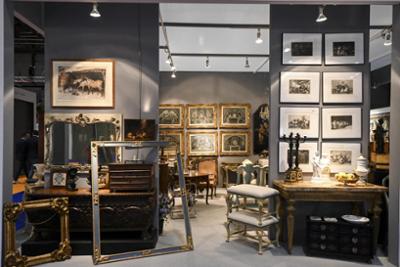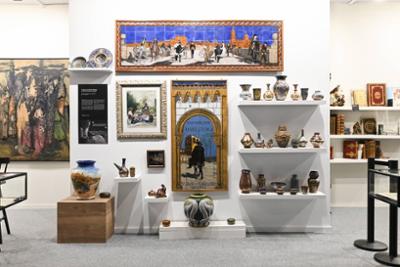

19th century Spanish painting

Spanish painting in the 19th century
The 19th century stands out as one of the most tumultuous periods in our history, characterised by a series of revolutions and radical changes in the political, social and cultural spheres.
From an economic perspective, this century saw the development and spread of the Industrial Revolution from Britain to the rest of the world, triggering an unprecedented process of transformation. In the social sphere, it saw the disintegration of the class society and its replacement by a class-based structure.
The bourgeoisie emerged as the new ruling class, while the proletariat, which emerged as a consequence of incipient industrialisation, took a prominent place in the social structure. The Industrial Revolution also led to the rapid growth of urban areas. On the political level, there was the progressive replacement of absolute monarchies by constitutional systems, as well as the rise of great colonial empires in Africa and Asia by European powers.
At the cultural level, there was evidence of the emergence of a mass culture, driven by advances in education, the press and communications, which contributed to the creation of a greater number of collective identities. Contact with non-European cultures, both through colonialism and incipient globalisation, enriched and diversified the cultural landscape of the time, leading to greater cultural exchange.
All these transformations greatly affected painting. However, the pictorial currents that developed during this century in Spain were not in line with the rest of the European artistic trends. The great political, social and economic instability that took place in Spain during the 19th century (the reign of Ferdinand VII, the Regencies, Isabel II, the democratic Sexenio and the Restoration of Alfonso XII), together with the weight of artistic tradition, meant that Spain was late in incorporating the air of renewal and innovation coming from Europe.
The survival of Neoclassicism during the first third of the 19th century
The 19th century in Spain really began with the War of Independence, a period in which the neoclassical style promoted by the enlightened monarchy of Charles III and the Academies was still in force, although at this time it began to coexist with other more novel trends. Nevertheless, the simplicity, heroism and mythological and symbolic grandeur of authors such as Francisco Bayeu and Salvador Maella remained fundamental pillars for the new generations of the new century, as did the influence of foreign painters such as Anton Raphael Mengs and Giambattista Tiepolo.
In this respect, we cannot fail to mention the transcendental figure of Francisco de Goya. His work is a faithful reflection of the spirit of the times and the convulsive historical period in which he lived, as we can see in the works The Second and Third of May 1808 in Madrid or the series of prints of The Disasters of War, in which he managed to capture the horrors of the conflict with great dramatism.
The great figure of Goya and the group of disciples and collaborators who followed his style, among whom names such as Agustín Esteve, Asensio Julià and José Ribelles stand out, were followed by a series of medium-quality painters who worked during the reign of Ferdinand VII. However, outstanding figures were Zacarías González Velázquez and Vicente López, both of whom were still indebted to the 18th-century past but adapted to the new prevailing aesthetic. We should not forget the figure of José de Madrazo, an artist greatly influenced by the French style of Jacques-Louis David, who inaugurated a long dynasty of painters that would dominate the rest of the 19th century, or Valentín Carderera, an artist who in his last period ended up imbued with the sensibility of Romanticism.
The emergence of Romanticism in the second third of the 19th century
Neoclassicism gave way, around 1830, to the Romantic spirit, coinciding with the development by foreign travellers of an exotic and idealised vision of Spain, which they saw as still anchored to the aesthetics and customs of the past. Traditionally, the beginning of pictorial Romanticism in Spain has been considered to be due to the activity of two painters from Cadiz, Juan Rodríguez "el Panadero" and Joaquín Manuel Fernández Cruzado, who developed especially popular and genre scenes.
Costumbrismo developed strongly at the time, with Madrid being the main centre of attention, where we find artists of the stature of Leonardo Alenza and Eugenio Lucas Velázquez, and family sagas such as the Cabral Bejaranos and the Domínguez Bécquer families. Meanwhile, in Catalonia, painters such as Pau Milà i Fontanals and Pelegrí Clavé i Roqué were linked to the Nazarene movement, a religiously inspired trend whose founder was the German painter Johann Friedrich Overbeck.
Other genres in the painting of the period
Other genres that underwent significant development at this time were portraiture - which, far removed from academic norms, tended to highlight the psychology of the sitter, his passions and preferences - with painters such as Antonio María Esquivel and Federico de Madrazo; landscape painting - for the first time as an independent artistic genre, far removed from bucolic clichés and reflecting the moods of the artist and the sitters - with Genaro Pérez Villaamil and Antonio Brugada; and Orientalism - a consequence of contact with the Orient, which in Spain arose on the basis of the cultural and historical heritage of Andalusia and Africa - developed by painters such as Francisco Lameyer.
The middle years of the century witnessed the development of a phenomenon - which was then enjoying a boom throughout the world - that would mark a turning point in the development of nineteenth-century painting: the National Exhibitions. Based on the model proposed by the Paris Salon, this new system of protection meant that artists were transformed into genuine free professionals and art was able to evolve in accordance with the social circumstances of the time. From 1856 and every two years, the artists of the time took part in these exhibitions, exhibiting their works and competing for prizes - which were usually won by paintings on historical themes - as well as for official acquisitions, thus facilitating public involvement and the emergence of specialised critics.
Historicism and Realism in the third third third of the 19th century
During the last decades of the 19th century Spain witnessed the emergence of a complex pictorial scene in which artists from many different fields converged. History painting undoubtedly acquired particular importance as a result of the aforementioned National Exhibitions. Painters such as Eduardo Cano, José Casado del Alisal, Vicente Palmaroli and Eduardo Rosales were some of its main representatives. At the same time, landscape painting continued to develop thanks to Carlos de Haes and his disciples, who were followed by other artists from all over Spain, including Martín Rico, Emilio Sánchez Perrier and Ramón Martí i Alsina. Costumbrista painting, for its part, turned its attention to the recreation of 18th-century scenes, resulting in the so-called casacón painting developed by artists of the stature of Mariano Fortuny and the Jiménez Aranda brothers.
At the same time as history painting and house painting began to wear out in the last decades of the 19th century, a social concept of painting that found its inspiration in everyday reality took hold. Painters such as Raimundo de Madrazo and José García Ramos were part of this trend. Finally, with regard to Impressionism, it should be noted that, although it arrived in our country late and did not take hold in the same way as in other countries, we find some artists influenced by this aesthetic, such as Aureliano de Beruete and Darío de Regoyos.
A case apart would be Joaquín Sorolla, whose style, characterised by paying special attention to the effects of light, made him the great figure with which the 19th century came to an end and the new 20th century was ushered in.
Daniel Alvarado Santiago
Paula Jurado Amador





